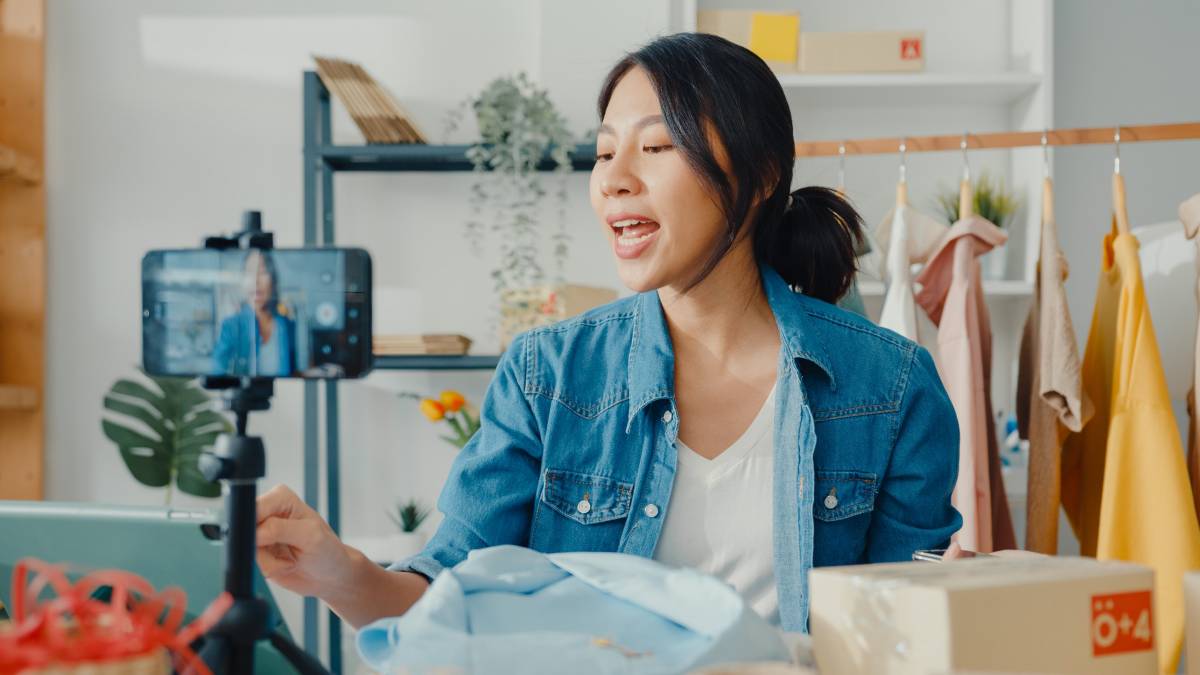
For most businesses, vertical video is the way to go—it’s mobile-first, full-screen, and drives higher engagement on today’s top platforms. But horizontal video still has its place on YouTube and other long-form content.
There was a time when all social media video content was filmed horizontally without a second thought. The landscape (no pun intended) has changed, and today, there’s a lively debate over horizontal vs vertical video.
| Horizontal Video | Vertical Video |
| Best for YouTube, websites, long-form content | Best for TikTok, Instagram, and other short-form video content |
| Professional, cinematic look | Mobile-first, fills screen |
| Great for events, landscapes, product demos | Great for personal, behind-the-scenes, fast engagement |
| Wider view = more context | Intimate feel = higher engagement |
Horizontal vs Vertical Video: The Case for Horizontal Filming
The Power of Horizontal Filming
Horizontal filming has long been the go-to choice for filmmakers and content creators alike. Why? Quite simply, it aligns with how we naturally see the world. Our eyes are side by side, favoring a wider view. This ‘landscape’ aspect ratio has dominated traditional media, from cinemas to television screens, creating an immersive experience that draws viewers into the action.
A Professional Touch
Beyond historical preferences, horizontal videos offer a sense of professionalism and quality. In a way, it’s like a universal language that audiences instinctively understand and appreciate. For instance, consider a stunning panoramic view of a beach at sunset. Horizontal videos capture the expanse of the scene, allowing viewers to soak in the full spectrum of colors and details.
Showcasing Broader Perspectives
This format is perfect for showcasing environments or activities that require a broader perspective. Whether it’s a fashion runway, an event, or a product demonstration, a horizontal video format provides a canvas that can include more elements, more action, and ultimately, more story. It creates an opportunity to convey a sense of place and space that vertical video formats simply cannot match.
Enhancing Product Presentations
Imagine you’re launching a new line of kitchen appliances. Filming in a horizontal video format allows you to set the scene, placing your products in context within a beautifully arranged kitchen. This format not only highlights the product but also its usability and lifestyle appeal. Horizontal filming can make the difference between a simple product shot and an engaging narrative that pulls the viewer in. By utilizing the full width of the frame, you can create a more appealing, comprehensive view that enhances the perceived value of what you’re offering.
Learn more: Ultimate Guide to Success: How to Grow a Small Business
Horizontal vs Vertical Video: The Rise of Vertical Filming
Embracing the Smartphone Era
Enter the smartphone era, where vertical format filming has risen to prominence, driven by platforms like Instagram Stories, Snapchat, and TikTok. This format aligns seamlessly with how we naturally hold our phones, making it an instinctive choice for quick, on-the-go video sharing. The prevalence of vertical content on these platforms has transformed it into the norm, favored for its ability to fill the screen and capture attention with minimal effort. This shift has ushered in a new era of content creation, where vertical is not just acceptable but often preferred.
The Advantages of Vertical Video
Vertical video offers unique advantages for social media engagement. It fosters a more intimate connection with the viewer, as the content feels personalized and immediate. The entire screen of a mobile device becomes a canvas, eliminating distractions and focusing attention squarely on the message. This format is particularly effective for engaging mobile users who scroll through content at lightning speed. By utilizing vertical content, brands can quickly capture their attention, increasing the likelihood of interaction, shares, and ultimately, brand visibility.
Real-World Examples
Take, for example, a small boutique bakery that launches a vertical video campaign showcasing mouthwatering pastries. By utilizing the full height of the screen, they can create visually striking content that highlights the intricate details of their creations. Similarly, consider a local gym that shares personalized video messages of workout tips—easily digestible content for a busy user’s day. These examples underscore how small businesses effectively leverage vertical content to connect with their audience, drive engagement, and boost their brand presence on social media platforms.
Learn more: Cracking the Code: Identifying Your Small Business Target Audience
How to Decide Between Horizontal vs Vertical Video
Understand Your Audience
Understanding your audience is key to choosing the right format. For instance, younger demographics might lean towards vertical video due to their affinity for platforms like Instagram and TikTok. In contrast, an older audience may appreciate the familiarity and quality associated with horizontal videos. To gain valuable insights into your audience’s preferences, consider conducting surveys or analyzing engagement metrics. This approach can help you tailor your content strategy for maximum impact.
Consider Platform Guidelines and Best Practices
Moreover, each social media platform has its own set of guidelines and best practices that influence format choice. For example, Instagram Stories and IGTV thrive on vertical content, while YouTube traditionally favors the horizontal video format. Understanding these nuances is essential for optimizing your filming approach accordingly. By aligning your content with platform specifications, you can enhance visibility and ensure a seamless viewing experience for your audience.
Determine Your Content Nature and Format
Finally, the nature of your content should also play a crucial role in your filming decision. For example, product demos or tutorials may benefit from a horizontal video format, allowing for more comprehensive coverage. In contrast, behind-the-scenes footage or personal vlogs might be better suited to the vertical format, offering a more casual and relatable feel. By assessing the objectives of your content, you can choose the format that best supports your storytelling goals.
Tips for Maximizing Impact with Social Media Content
Maximizing Impact with a Hybrid Approach
To truly maximize impact, consider adopting a hybrid strategy. Utilize horizontal video format for platforms like YouTube and Facebook, where longer-form content thrives, while reserving vertical content for Instagram Stories and TikTok, where quick, punchy videos reign supreme. This diversification allows you to reach a broader audience and ensures your content is optimized for each platform’s unique strengths.
Enhancing Vertical Content
Creative text overlays, graphics, and captions can elevate vertical videos. These elements not only add visual appeal but also convey key messages effectively, especially when sound is muted. By enhancing your vertical content with these features, you can create an engaging and immersive experience that resonates with your audience.
Importance of Testing and Analysis
No strategy is complete without thorough testing and analysis. Experiment with both formats, track performance metrics, and gather insights on what works best for your business. Focus on engagement rates, viewer retention, and conversion metrics to determine which format yields the best results. This data-driven approach will empower you to refine your content strategy and drive success.
Learn more: Top Content Creation Strategies for Small Businesses
Final Thoughts
As a small business owner, it’s essential to embrace experimentation with both formats. By testing them across different platforms and analyzing your audience’s engagement, you can allow data to guide your strategy. So go ahead and get creative with your content – whether it’s filmed horizontally or vertically! There are no limits in the digital world. Keep exploring and discovering new ways to engage with your audience through captivating visuals and meaningful messages.
Are you ready to elevate your social media game? Join us at the next event hosted by The Small Business Expo, where we’ll dive into pressing questions just like this one. Connect with fellow entrepreneurs, share insights, and discover the best practices for optimizing your content. Don’t miss this chance to enhance your understanding and take your business to the next level—register now and be part of the conversation!
Should Social Media Content Be Filmed Horizontal Or Vertical FAQs
What impact does video orientation have on viewer engagement for small businesses?
Video orientation can significantly affect viewer engagement by aligning with user habits on specific platforms. Vertical videos tend to increase engagement on mobile-centric platforms due to their natural alignment with the way users hold their devices.
How does video orientation influence brand perception on social media?
Consistent video orientation helps maintain a professional and cohesive brand image, ensuring that content looks polished and intentional. Choosing the right orientation for each platform can enhance the audience’s perception of a brand’s adaptability and attention to detail.
Can using the wrong video orientation affect a small business’s reach on social media?
Yes, using the wrong orientation may limit a video’s reach due to poor viewer experience, potentially leading to reduced engagement and visibility. Platforms often prioritize content that matches their preferred format, so aligning videos with platform specifications can help maximize exposure.
What are the technical considerations when deciding on video orientation for social media?
Pay attention to resolution and aspect ratios, ensuring videos look clear and well-framed in both horizontal and vertical formats. Testing how each orientation displays on different devices can also help optimize content for a seamless viewing experience.
How can small businesses repurpose content across platforms with different orientation preferences?
Create versatile content by filming in a way that allows for easy cropping or editing between formats. Consider using editing tools to adjust orientation post-production, enabling the same content to be effectively shared across multiple platforms.
Can businesses use both horizontal and vertical video formats effectively?
Yes — businesses can and should use both formats strategically. Horizontal video works best for YouTube, websites, and long-form, professional storytelling. Vertical video excels on mobile-first platforms like TikTok, Instagram, and Snapchat, where full-screen, quick engagement matters most.
